As an Amazon Associate I earn from qualifying purchases.
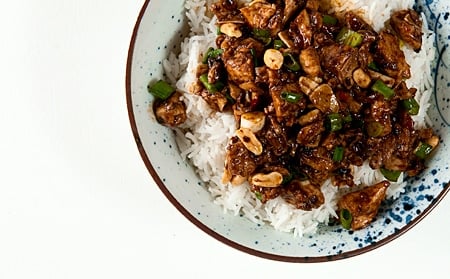
Anyone who has read this space for any length of time knows how much I love wild game recipes that are outside the Western tradition. It’s not that I dislike the foods of Europe or America, it’s just that I am fascinated with how the rest of the world treats its game — after all, most of the cultures on this planet hunt.
So thanks to Fuchsia Dunlop, whose Chinese regional cookbooks always have at least a few game recipes. I found this dish in her Sichuan cookbook, Land of Plenty. I have modified her recipe to suit wild rabbits, which are smaller, denser and can be a lot tougher than a domestic bunny.
Squirrels will also work really well in this recipe, too. Oh, and if you are skeeved out by eating rabbits and squirrels, you can use chicken as a replacement. But I hope you possess the intestinal fortitude to cook with rabbit.
I’ve done a few other riffs of Dunlop’s work, including kung pao pheasant, which is one of my favorite pheasant recipes.
Back to this Sichuan rabbit dish. Blessed with a rabbit that Holly brought home, I wanted to make it stretch for the two of us. This recipe did the trick.
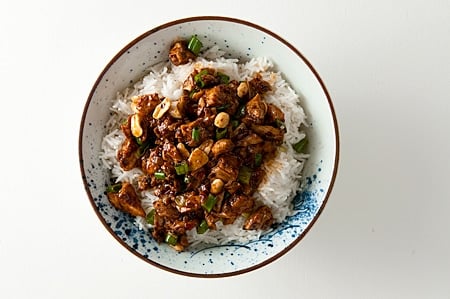
Basically, you gently braise the rabbit, then pull or cut all the meat off the bones. Cube it, then toss the meat with a spicy mixture of chile paste, black bean paste, soy, scallions and peanuts. It’s pretty damn awesome, especially if you make the special topping Dunlop attributes to a Chengdu woman named Chen Yonghui: peanuts, Sichuan peppercorns and toasted sesame seeds, all toasted and ground.
A word on Sichuan peppercorns. They’re not actually pepper, and there is no substitute. They are very floral, almost citrusy — and they make your mouth a little numb. You can skip them, but using them makes this dish really authentic. Sichuan peppercorns can be found in some supermarkets, or you can buy them online.
Sichuan Rabbit with Peanuts
Ingredients
- 2 cottontail rabbits or squirrels or 1 domestic rabbit
- A 2-3 inch piece of ginger, unpeeled and chopped
- 1 small onion, chopped
- 4 tablespoons soy sauce, divided
- 2/3 cup roasted, salted peanuts
- 4 scallions, sliced thin
- 2 tablespoons black bean paste
- 3 tablespoons peanut oil or lard
- 2 tablespoons chile bean paste
- 1 tablespoon sugar
- 2 teaspoons sesame oil
OPTIONAL TOPPING
- 2 tablespoons minced peanuts
- 1 tablespoon sesame seeds
Instructions
- Simmer the rabbits. You can cut up your rabbits, or you can just chop them in half with a cleaver -- you're going to pull off the meat anyway. Cover them in water in a large pot and add the ginger, onion and 3 tablespoons of soy sauce. Bring to a boil, then drop the heat to low so you barely have any bubbles. Simmer like this until the meat wants to fall off the bone, maybe 45 minutes to an hour, or up to 2 hours for an old squirrel.
- While the rabbit is cooking, make the topping by toasting the sesame seeds, sichuan peppercorns and minced peanuts in a dry pan over medium-high heat until they are fragrant, about 1-2 minutes. Move to a mortar and pestle and grind roughly. Set aside.
- When the rabbit is done, move it to a platter and allow to cool somewhat. Strip the meat off the bones and chop into cubes. Set aside in a large bowl.
- In a wok or a saute pan, heat the peanut oil over high heat. Add the black bean paste and the chile bean paste and stir-fry for 30 seconds to a minute. Turn off the heat and mix in the sugar, sesame oil and remaining soy sauce.
- Pour the sauce into the bowl with the rabbit and toss with the peanuts and the scallions. Serve at once over rice.
Nutrition
Nutrition information is automatically calculated, so should only be used as an approximation.

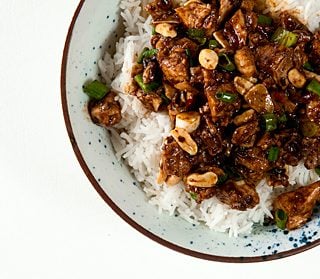

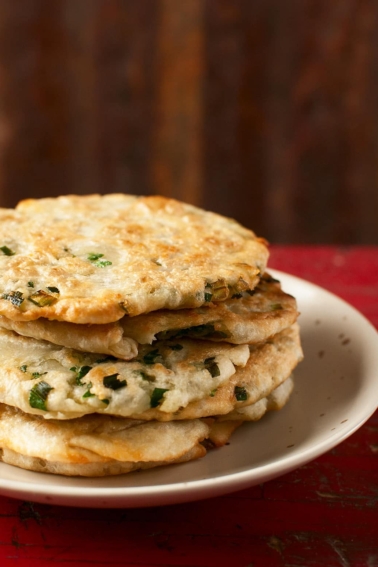
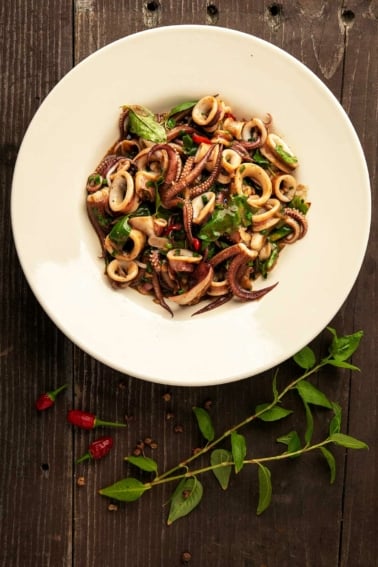

Absolutely love this recipe. Made it last night with pine squirrel! The ingredient lists forgets to mention the sichuan peppercorns, I’ll have to add that next time.
Black bean paste in Sichuan cooking. No! Doubanjiang? Yes.
Liuzhou: I totally understand, but it can be very hard to find doubanjiang here in the US, and black bean paste is more common. Just trying to help people here make something sort of similar to real Sichuan food.
Fuchsia Dunlop is a genius. I have all her books so the Fuchsia is bright.
Happy to report that this recipe works with venison too – the crock pot does an excellent job of getting the meat tender while away at work, and the rest of the stir-fry comes together faster than it takes to cook the rice. Perfect for a weeknight – stupid easy and stupid good!
Looking at the recipe, I don’t see the peppercorns. How much do you use?
Christine: Not much. I like to lightly crush about a teaspoon or less and toss them in about 90 seconds before the stir fry is done.
No longer have rabbits, so made this with leg quarters of very old stewing hens. Excellent. Prepped the hen parts in my instant pot for 40 minutes at high pressure. Forgot to throw in the onion, and didn’t miss it.
Grateful for John Kendon’s comment. I just bought a rabbit to cook for the first time, and my Asian hubby loves to eat food with small bones still in it. I will try this recipe chopped on the bone ^^
hi, i am an aussie but my wife is from chengdu in sichuan, and one thing i have noticed is that chinese usually do not pull meat off the bone; they cook on the bone chopped up and like it this way. wife (tai tai) makes this almost same way and is yummy..
I tried making this with squirrel and it was fantastic. Thank you for a great recipe.
I used Hare it was easily one of the best dishes I have ever made and i have been cooking for over twenty years. 🙂
Thanks again.
Cam
Thanks for the inspiration; I am going to use a brown hare instead 🙂
This sounds absolutely fabulous! Can’t wait to try this. Just discovered your website. love it. Thanks
I made this and loved it, but it came out a tad salty. It was probably my black bean paste. Was curious how authentic a preparation like this is? I thought the same method would make a very respectable (and incredibly fast) meal with a rotisserie chicken too.
Wow, This sounds fabulous. I don’t know why we never think of rabbit in Chinese food, let alone Sichuan. The Sichuan pepper in it, especially enticing. Have you seen Poivre Timut? I don’t know what it’s called in English, but comes from Nepal, and is definitely related to Sichuan pepper corns, but I think a little sweeter and more fragrant.